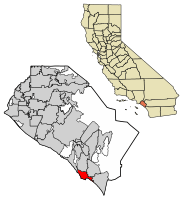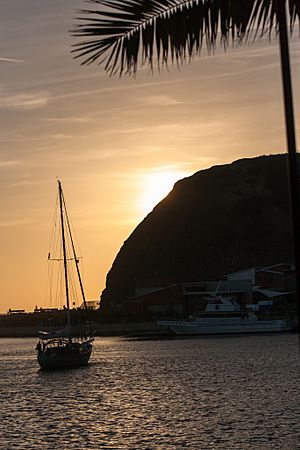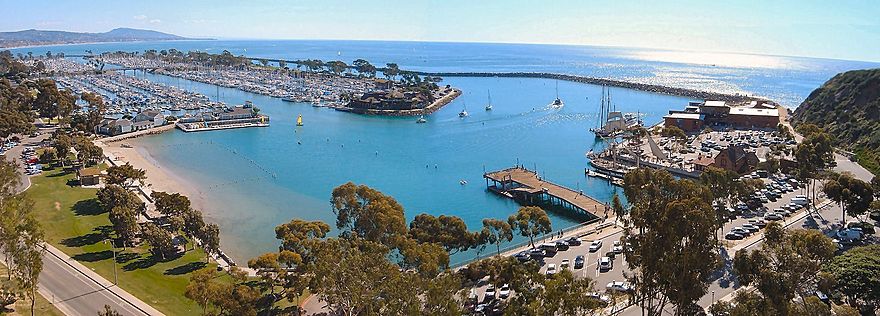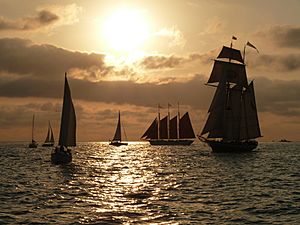Dana Point, California facts for kids
Quick facts for kids
Dana Point, California
|
||
|---|---|---|

Aerial view of Dana Point
|
||
|
||
| Motto(s):
"Harboring the Good Life"
|
||

Location of Dana Point in Orange County, California
|
||
| Country | United States | |
| State | California | |
| County | Orange | |
| Incorporated | January 1, 1989 | |
| Named for | Richard Henry Dana, Jr. | |
| Government | ||
| • Type | Council-Manager | |
| Area | ||
| • Total | 6.75 sq mi (17.49 km2) | |
| • Land | 6.49 sq mi (16.80 km2) | |
| • Water | 0.26 sq mi (0.68 km2) 77.96% | |
| Elevation | 144 ft (44 m) | |
| Population
(2020)
|
||
| • Total | 33,107 | |
| • Density | 5,102.81/sq mi (1,970.18/km2) | |
| Time zone | UTC−8 (Pacific) | |
| • Summer (DST) | UTC−7 (PDT) | |
| ZIP Codes |
92624, 92629
|
|
| Area code(s) | 949 | |
| FIPS code | 06-17946 | |
| GNIS feature IDs | 1656474, 2410293 | |
| Reference #: | 189 | |
Dana Point is a city located in southern Orange County, California, United States. The population was 33,107 at the 2020 census. It has one of the few harbors along the Orange County coast, and with ready access via State Route 1, it is a popular local destination for surfing.
The city was named after the headland of Dana Point, which was in turn named after Richard Henry Dana, Jr., author of Two Years Before the Mast, which included a description of the area. Dana described the locale, including neighboring San Juan Capistrano, as "the only romantic spot on the coast". This area is designated California Historical Landmark #189.
Contents
History
Dana Point was a popular port for ships involved with the hide trade with nearby Mission San Juan Capistrano. Trading reached its peak in the 1830s and 1840s. In 1818, Argentine sailor Hippolyte de Bouchard anchored there while conducting his raid on the mission. Richard Henry Dana then visited the area in 1835 while serving aboard the sailing brig Pilgrim on her voyage along the California coastline.
In 1923, Los Angeles Times publisher Harry Chandler and General M. H. Sherman, director of the Pacific Electric Railway Company, created a major real estate group to develop what is known today as the Hollywood Hills. Sidney H. Woodruff, already a prominent Los Angeles homebuilder, was hired to lead the project.
In 1926, Woodruff, Chandler, and Sherman created the Dana Point Syndicate. They invited other investors, company presidents, movie producers, and real estate investors to join them in purchasing 1,388 acres (5.6 km2) of land, some of which includes the "Headlands" of today. Promising tree-lined and paved streets, electricity, telephones, sidewalks, water mains, storm drains, sewers, and other amenities, Woodruff built 35 homes and a number of commercial buildings.
Most of these "Woodruff" houses are concentrated in the Dana Point historic core, also called Lantern Village (currently about 12,000 residents). The streets are named after different colored lanterns—Street of the Violet Lantern, Blue Lantern, etc.—because colored lanterns were used by ships 200 years ago to advertise their fares when in the Dana Point natural harbor. shaft was dug for an elevator to transport hotel guests to and from the beach. The economic downturn of the Great Depression caused construction to halt, however. Although Woodruff continuously sought financial support through the years, this project was abandoned in 1939. Subsequently, he sold the remaining holdings of the Dana Point Syndicate. Thirty-four of the original Woodruff residences are still occupied.
Dana Point Harbor
The harbor, built in the 1960s and dedicated on July 31, 1971, is home to a marina, shops, and restaurants, and it is a point of departure for the Catalina Express, a transportation service to and from the City of Avalon on Catalina Island. The entire harbor of Dana Point, including the Embarcadero Marina shops and restaurants are set for complete demolition and redevelopment. The current vintage nautical style is being abandoned for a Tech Minimalist concept using metal roofs as well as Minimalist landscaping.
Strands
The Strands at Headlands is a luxury housing development built on land that was originally part of the Chandler Family holdings. For decades the land facing the beach was home to the Dana Strand Beach and Tennis Club, a mobile home community that closed in the late 1980s. For years, access to the Strands beach was limited to hiking down a dirt trail where the mobile homes had stood. The Strands parcel included the actual headlands and bluff of Dana Point as well and was one of the last large coast properties available for development along the Orange County Coast. During the course of a ten-year approval process, the original high density plan, which included a large multi-story hotel on the bluff top and hundreds of houses and multi-family units, was reduced in scope to just over 100 home sites. As part of negotiations with the California Coastal Commission, the developer agreed to turn the bluff into a nature preserve and build over $11 million worth of public improvements to provide easier access to the Strands Beach. The improvements include stairs, restrooms, a beach-front sidewalk and a funicular to transport visitors from the parking lot to the beach. After extensive infrastructure construction, lots were offered for sale in the fall of 2006. Lots in the development are rectangular with modern houses commonly priced above $10,000,000. The development has provided much easier access to the beach below and has allowed surfers and other beach visitors to access the beach quickly and easily. Strands Homeowners, through a Mello-Roos assessment, pay for the upkeep of the beach improvements.
Capistrano Beach
In 1928, a corporate entity of the American industrial giant Edward Doheny, who had built his fortune in oil production in Southern California and Mexico, purchased a number of lots in Capistrano Beach. Doheny's son, Ned, formed a development company, the Capistrano Beach Company, which included his wife's twin brothers, Clark and Warren Smith, and Luther Eldridge, a contractor, to build a community of Spanish style houses. According to Dana Point historians Baum and Burnes,* Eldridge favored two dominant characteristics in his homes, a typically Spanish roof line and the use of large ceiling beams in the main rooms of the houses. The roofline, covered with red ceramic tiles, incorporated a low-pitched gable, spreading out to one short and one long roof. The ceiling beams were decorated with stenciled artwork painted by artist Alex Meston. Eldridge was able to complete the original Doheny family house on the bluffs, four houses on the beach, and 18 other homes scattered throughout the area before tragedy struck the ambitious project. Edward Doheny was preparing for his criminal trial for bribery in the Teapot Dome Scandal, and on February 16, 1929, Ned Doheny and, Hugh Plunkett, his friend and secretary, who were to testify in the trial, were killed in a murder that still remains unsolved. In 1931, as a memorial to Ned, Petroleum Securities Company, Doheny's family-owned business, made a gift of 41.4 acres (168,000 m2) to the State of California, which is now Doheny State Beach. The unimproved Capistrano Beach properties passed back to Edward Doheny, and, upon his death in 1935, to his wife and heirs. By 1944, all of the properties had been sold to private parties.
The Doheny family also funded the building of what was then called St. Edward's Chapel in Capistrano Beach. The chapel soon grew, received canonical status as a parish, and moved to its current bluff-top location in Dana Point, overlooking Doheny State Beach.
Surfing
Richard Henry Dana (the author of "Two Years Before the Mast") considered the high bluffs and sheltered coves of this area of Southern California to be the most beautiful spot on the California coast. Pioneering surfers agreed, as they surfed the many beach breaks along the coast. Dana Point had a notable surfing history, and was home to many of the first companies that produced products for surfing. Hobie Alter opened the world's first retail surf shop in Dana Point in 1954. Many surf publications such as the Surfer's Journal and Surfer Magazine were formed and headquartered in Dana Point. Bruce Brown produced the iconic surfer film Endless Summer in Dana Point.
"Killer Dana" was a legendary surf break off Dana Point. The surf break was notorious because it came out of deep water and broke close to the rocks that lined the beach. The Killer Dana wave was destroyed when the Dana Point Harbor was built in 1966. A breakwater now cuts right through the heart of the once epic surf spot. In 1997, the surf group The Chantays recorded an instrumental track named "Killer Dana".
Geography
According to the United States Census Bureau, the city has a total area of 29.5 square miles (76 km2). 6.5 square miles (17 km2) of it is land and 23.0 square miles (60 km2) of it (77.96%) is water.
The Dana Point headlands are a prominent feature in Orange County geography and after years of controversy, are currently being developed as a 118-house gated community, however 68 acres (280,000 m2) of the site is open to the public and features a nature center and walking trails exhibiting "lost" plants of the Southern California coast. Views on a clear day extend to Catalina Island and La Jolla in San Diego county. link Dana Point Headlands
 |
Laguna Beach | Laguna Niguel | San Juan Capistrano |  |
| Pacific Ocean | San Juan Capistrano | |||
| Pacific Ocean | Pacific Ocean | San Clemente |
Climate
Dana Point enjoys a mild climate where temperatures tend to average around the 70s. The warmest month of the year is August with an average temperature of 79 °F (26 °C). The coldest month is December with an average minimum temperature of 65 degrees Fahrenheit.
Marine life
One of the very few known specimens of the megamouth shark was caught off Dana Point in 1990. Visitors can visit the Ocean Institute at the harbor below the point and the tidal pools located nearby for a closeup view of marine life during low tide. With the kelp beds located just offshore, Dana Point is a popular destination for snorkelers, fisherman, and spear fishers.
Demographics
| Historical population | |||
|---|---|---|---|
| Census | Pop. | %± | |
| 1960 | 1,186 | — | |
| 1970 | 4,745 | 300.1% | |
| 1980 | 10,602 | 123.4% | |
| 1990 | 31,896 | 200.8% | |
| 2000 | 35,110 | 10.1% | |
| 2010 | 33,351 | −5.0% | |
| 2020 | 33,107 | −0.7% | |
| U.S. Decennial Census | |||
2010
The 2010 United States Census reported that Dana Point had a population of 33,351. The population density was 1,131.1 people per square mile (436.7/km2). The racial makeup of Dana Point was 28,701 (86.1%) White (76.4% Non-Hispanic White), 294 (0.9%) African American, 229 (0.7%) Native American, 1,064 (3.2%) Asian, 37 (0.1%) Pacific Islander, 1,952 (5.9%) from other races, and 1,074 (3.2%) from two or more races. Hispanic or Latino of any race were 5,662 persons (17.0%).
The Census reported that 33,110 people (99.3% of the population) lived in households, 160 (0.5%) lived in non-institutionalized group quarters, and 81 (0.2%) were institutionalized.
There were 14,182 households, out of which 3,459 (24.4%) had children under the age of 18 living in them, 6,902 (48.7%) were opposite-sex married couples living together, 1,232 (8.7%) had a female householder with no husband present, 645 (4.5%) had a male householder with no wife present. There were 780 (5.5%) unmarried opposite-sex partnerships, and 137 (1.0%) same-sex married couples or partnerships. 4,012 households (28.3%) were made up of individuals, and 1,406 (9.9%) had someone living alone who was 65 years of age or older. The average household size was 2.33. There were 8,779 families (61.9% of all households); the average family size was 2.85.
The population was spread out, with 5,959 people (17.9%) under the age of 18, 2,522 people (7.6%) aged 18 to 24, 8,261 people (24.8%) aged 25 to 44, 10,927 people (32.8%) aged 45 to 64, and 5,682 people (17.0%) who were 65 years of age or older. The median age was 44.8 years. For every 100 females, there were 98.2 males. For every 100 females age 18 and over, there were 96.9 males.
There were 15,938 housing units at an average density of 540.6 per square mile (208.7/km2), of which 8,314 (58.6%) were owner-occupied, and 5,868 (41.4%) were occupied by renters. The homeowner vacancy rate was 2.0%; the rental vacancy rate was 7.0%. 19,419 people (58.2% of the population) lived in owner-occupied housing units and 13,691 people (41.1%) lived in rental housing units.
According to the 2010 United States Census, Dana Point had a median household income of $80,938, with 8.4% of the population living below the federal poverty line.
As of the census of 2000, there were 35,110 people, 14,456 households, and 9,280 families residing in the city. The population density was 5,290.1 inhabitants per square mile (2,041.6/km2). There were 15,682 housing units at an average density of 2,362.8 per square mile (911.9/km2). The racial makeup of the city was 87.3% White, 0.8% Black or African American, 0.6% Native American, 2.5% Asian, 0.1% Pacific Islander, 5.9% from other races, and 2.8% from two or more races. 15.5% of the population were Hispanic or Latino of any race.
There were 14,456 households, out of which 26.2% had children under the age of 18 living with them, 51.4% were married couples living together, 8.8% had a female householder with no husband present, and 35.8% were non-families. 26.0% of all households were made up of individuals, and 7.1% had someone living alone who was 65 years of age or older. The average household size was 2.41 and the average family size was 2.90.
In the city, the population was spread out, with 20.6% under the age of 18, 7.1% from 18 to 24, 31.4% from 25 to 44, 28.0% from 45 to 64, and 13.0% who were 65 years of age or older. The median age was 40 years. For every 100 females, there were 100.1 males. For every 100 females age 18 and over, there were 98.4 males.
The median income for a household in the city was $63,043, and the median income for a family was $73,373 (these figures had risen to $81,665 and $97,826 respectively as of a 2007 estimate). Males had a median income of $52,159 versus $38,902 for females. The per capita income for the city was $37,938. About 3.4% of families and 6.7% of the population were below the poverty line, including 6.8% of those under age 18 and 5.3% of those age 65 or over.
In 2010 Dana Point had a population of 33,351. The median age was 44.8 years. The racial and ethnic composition of the population was 76.4% non-Hispanic white, 0.9% black or African American, 0.7% Native American, 3.2% Asian, 0.1% Pacific Islander, 0.2% non-Hispanic of some other race, 3.2% reporting two or more races and 17.0% Hispanic or Latino. Mexicans made up 13.2% of the population.
Annual cultural events
Dana Point has held a Festival of Whales since 1972. This celebration is held over two weekends in March.
The Tall Ships Festival is held in September. It is considered the largest annual gathering of its kind on the West Coast of the United States.
Dana Point has hosted the Dana Point Concours d'Elegance since 2008. The event is located on the Monarch Beach Golf Links and supports various charities.
The Dana Point Grand Prix is an annual criterium bike race overlooking Dana Point Harbor. The course winds its way through downtown Dana Point into Heritage Park and the adjoining residential community with ocean views for participants and spectators before finishing on a long straightaway on PCH. [1]
The Dana Point Chamber of Commerce hosts the annual Turkey Trot, which includes a 5K, 10K and Kids’ Gobble Wobble race for ages 5–12, which was voted as a top destination for Thanksgiving by Fodor's Magazine. This event attracts more than 10,000 runners throughout the country and another 5,000 family and friends.
The Dana Point Symphony [2] presents classical music concerts with a 50-piece orchestra and local and international soloists.
Education
The city is served by Capistrano Unified School District. It includes Dana Hills High School, one of the oldest high schools in the area, which opened in 1972. The cross country program at Dana Hills High School won California state titles in 1988, 2007, 2008, and 2009.
Notable people
- Magic Johnson
- Bernadette Withers
See also
 In Spanish: Dana Point para niños
In Spanish: Dana Point para niños









